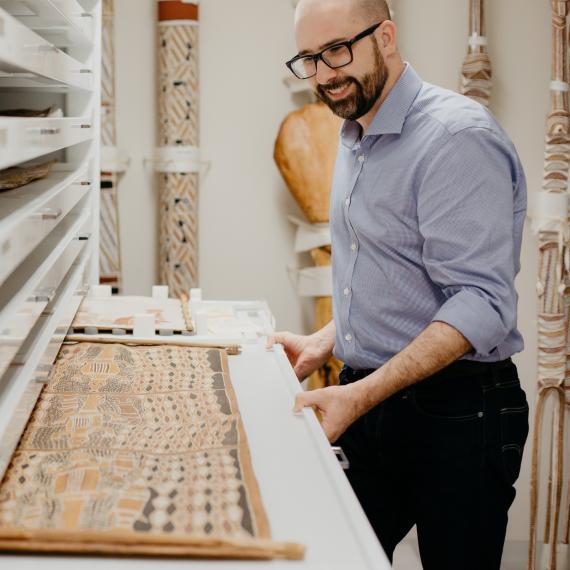
Women in Architecture & Film
Perth Design Week 2023 celebrated remarkable women in architecture and film in a panel discussion and award-winning film screening.
Urban planning and design define how cities function and people live.
When dealing with poverty, industry, social justice, and positive and creative communities, a move in one direction can have a multi-generational effect that may never be repaired or reconciled. On the other hand, visionary thinking goes beyond simply thinking about the function, making a lasting difference in the lives, communities, and economies of suburbs, cities and countries.
On Friday 24 March 2023, the Museum showed the award-winning films City Dreamers and Ascension. These two films take us into two worlds - one explores the visionary approach, the other, a symphonically chaotic race toward unbridled materialism in a developing economy.
As a part of this screening, audiences were invited to attend a very special pre-screening panel discussion with Australia's Government Architects - who are all women. The panel discussed the role of women in architecture, facilitated by Sandy Anghie WA President of the Australian Institute of Architects, and joined by;
- ACT Government Architect – Catherine Townsend FFRAIA
- NSW Government Architect – Abbie Galvin
- QLD Government Architect – Leah Lang
- VIC Government Architect – Jill Garner
- WA Government Architect – Rebecca Moore
This event was presented in association with the Revelation Perth International Film Festival and curated by Richard Sowada.
-
Episode transcript
Sandy Anghie: Hello and welcome everyone, and thank you for joining us at this very special Perth Design Week event presented by WA Museum in collaboration with the Office of the Government Architect, Revelation Films and Perth Design Week. My name is Sandy Anghie and I'm one of the co-creators of Design Week, along with David Smith. I'd like to begin tonight's event by acknowledging Traditional Owners of the land on which we meet, the Whadjuk Nyoongar people, and pay my respects to Elders past and present. I would also like to acknowledge here this evening with us Jessica Stojkovski MLA, Parliamentary Secretary for the Minister of Planning, Transport and Ports, and also Parliamentary Secretary to the Minister for Housing, Lands, Homelessness and Local Government. So, this event is really quite unprecedented in a number of ways. Well, first of all, a lot of us are sitting here on beanbags, which you probably didn't expect. We have five of our current government architects here in WA, which is quite unprecedented. Two of them happen to be from WA. Rebecca Moore, who you all know and Abbie, also from New South Wales, started here in WA. And in case you hadn't noticed, they're all women. <Audience cheers> So, before we get started with our conversation, I would like to introduce everyone to you.
So first of all, from WA we have Rebecca Moore. Rebecca was appointed Government Architect of Western Australia in September 2020. A highly credentialed architect with more than three decades of experience both in Perth and overseas, Rebecca has expertise in design, planning, heritage, and construction. During her time as a practicing architect, Rebecca was involved in projects in a wide range of domains, including commercial, heritage, education, residential, and adaptive reuse. Rebecca is also a nationally accredited mediator and a long-standing member of the State Administrative Tribunal.
From Queensland, Leah. Leah Lang. Leah was appointed Queensland Government Architect in September 2021, a huge role in the lead up to the 2032 Olympic Games. Leah is an experienced strategic design advisor and an award-winning registered architect. Notably, prior to this role, Leah served a four-year tenure as the Gold Coast City Architect, a coveted role with significant responsibility given the Gold Coast is Australia's sixth largest city and the nation's second largest local government authority. Here, Leah oversaw citywide design and planning policy and implementation.
Next, we have Victorian Government Architect, Jill Garner. Jill took the helm at the Office of Government Architect in Victoria in 2015, stepping into the role as a public advocate for architecture and design after more than 20 years in practice. As an architect, her practice received numerous industry awards delivering sensitive, crafted public and private work. Jill has taught at RMIT and Melbourne University. She is a past board member and examiner for the Architects Registration Board in Victoria. She's also a life fellow of the Australian Institute of Architects and in 2021 she was appointed a member of the Order of Australia, recognising her distinguished service to architecture, education, and professional associations.
From New South Wales, but originally from WA, Abbie Galvin. Abbie was appointed New South Wales Government Architect in 2019, bringing to the role international and Australian experience and a focus on design excellence and public spaces. Abbie joined BVN Architecture in the mid 1990s and rose to the position of principal and owner of the practice. She worked on large scale projects ranging from hospitals, multi residential housing, and research buildings. Throughout her working career, Abbie has been a dedicated contributor to an accreditation panel through the Australian Institute of Architects, her role consisting of mentoring and assessing university courses.
And finally, from the ACT, we have Catherine Townsend. Since her appointment as ACT Government Architect in September 2016, Catherine has overseen the introduction and implementation of the National Capital Design Review Panel. Her role also encompasses the provision of strategic advice to government across planning, construction, regulation, and the delivery of Canberra's evolution. Catherine retains involvement in the delivery of architecture as co-director of Townsend and Associate Architects. She is also active in the Australian Institute of Architects’ ACT chapter, past Chair of the ACT Architects Registration Board, and past President of the Architects Accreditation Council of Australia.
So, quite impressive bios from everyone up here on stage. So, let's get started. My first question is for background. I'd like to ask each of you: what are the key issues facing your state? Abbie, would you like to kick off?
Abbie Galvin: Sure. Well, we've just spent two days talking about some of the key issues that we're facing in our respective jurisdictions, and it's fair to say the most significant of those is certainly housing, and I'm sure we can all speak to different components of that. And a huge component of that, too, is climate resilience. And as you look at essentially what's constantly called a housing crisis, the issue of supply, the issue of affordability, we also have a significant concern in relation to quality of homes and being able to maintain that quality with a—you know, we're talking sort of high, medium or low density—as we reach this extraordinary speed. And something that we're very focused on at GA New South Wales is also thinking about the sort of the amenity that is kept alongside this race tohuge supply. And you know, I was reflecting on this. I did a beautiful run through Kings Park yesterday morning. And you sort of think about the huge and incredibly important decisions people have made about our cities and the provision of such an amazing urban amenity like Kings Park in the center of the city. Shenton Park Lake. Things that are sort of close to us. Supreme Court Gardens. You know, they have made such impacts in terms of amenity and provision as our cities grow, and we really need to sort of stand on the shoulders of giants and make sure that we're doing exactly the same thing, so that we're not developing without thinking also about those really important components of infrastructure that sit alongside them.
Sandy Anghie: Catherine?
Catherine Townsend: Thank you. So the, the big issues for, for the government architect in the ACT are peculiar to the fact that Canberra is a planned city, and it was, it's had a number of planning iterations, first by the Griffins, and then there have been a number of, more interpretations of the English New Town system. And that has given Canberra both challenges and opportunities. And so, a lot of my job is about, how do we grow our city? How do we, how do we double our population over the next 50 years and achieve 70% of that population growth within the existing footprint of our city? So that's a real challenge in, how do we how do we densify the city? How do we retain its wonderful qualities? How do we fix some of its really embedded problems, some of those wicked problems? And it's, I think, a lot of the characteristics of what we're dealing with are, you know— We're at that point where the planning seesaw is just tilting over the last generation. Planning has really been, it's been purely about economics, yield, and sort of cars. Vehicles. And now we've got to build in a much more robust response to the people who live in the city and I often characterise, you know, the buildings of the past are often psychopathic buildings. You know, they're not particularly friendly. They're not particularly, you know— They're buildings that are all about the me, me, me. They're all about themselves. And so what we want to do is encourage buildings that are really socially responsible, climatic and environmentally responsive. And buildings must be like people. They must, they must be polite and have an engaging personality and be easy to get along with. So, you know, in a nutshell, that's what we try and facilitate.
Sandy Anghie: Sounds good. Leah?
Leah Lang: Thanks, Sandy. Um, yep, we have very similar issues. So, obviously housing. We had a housing summit in response to a housing crisis with some of the lowest vacancy rates we've ever seen in Queensland, and that's resulted in some significant planning policy and changes. And the Office of Government Architect has been right up with that. Our idea is that it is all about a good home across the whole housing continuum. So whether that's home ownership, rental, built-to-rents, affordable social housing, the premise is of a good home, and the services that we provide to wrap around those for the people that need them is an additional overlay. But at all fundamental points we should be providing a good home as a human right. So, we've done a lot of work in that space. And then, obviously, the glamorous side of it is the Olympic and Paralympic for 2032. So that's keeping us very busy. A colleague of mine, [indecipherable] doing a brilliant job of that about background reports on benchmarking global stadiums and arenas with pivoting to the new philosophy of the IOC, which is to fit the Olympics within the city so there's no more forceable white elephants being built bankrupting cities. It really is about maximizing what you have and utilising the parts of the city to celebrate the Games and hopefully utilise existing facilities or build ones that you are just simply bringing forward in an infrastructure program. And finally, as I started, I think it was two months in, we had catastrophic floods in Queensland. So putting through a resilience program for flood, where it's buybacks, raising, and resilient build, and just educating the community about how we will in future withstand natural hazards. Queensland's particularly prone as is WA to fires, cyclones, and floods. We get all of them and at heat and a few others. It is, it’s a complex environment in which to build and we need our buildings to respond better. So, that's also a program of works we look at.
Sandy Anghie: Thanks, Leah. Jill?
Jill Garner: What I've been thinking about over the last couple of days, as we've been talking about our own problems in our own state: ten years ago when I first joined the Government Architects Office in Victoria, there was no or very limited public work taking place, so there just wasn't that much activity. And I even had architects ringing me saying, how can we get the government to build more? You know, how can we get stuff happening? And since then, I guess it took a few years and we had a change of government. We've now, we are so embedded in what Victoria has called the big build and I have never seen so much work in my life, in terms of infrastructure projects and so. Housing is a huge issue like everybody else. But the other huge issue that is going with it is roads. And we are involved in what roads look like; how they interact with the landscape that they work through; how we solve the noise problem between the road and the residential environment; and that problem, we've got that one of the biggest problems which doesn't exist in every city in Australia is our problem of urban sprawl, because basically Melbourne has no topography, we are flat and we could just keep marching to Perth, really, [audience laughter] if we just keep going. So we've but we've got a fantastic inner urban and middle urban transport network. It's quite brilliant, it's busy, it's, it's used, heavily used. But we've got our outer suburbs as they crawl further and further beyond our city center, which is still a place of commerce. People still come into the city to work. We don't have a city that has got multiple centres like Sydney. So we really have this problem of people driving for an hour and a half to get to the city, to get to the office or getting on a train for that. And we are building homes further and further out. So, as we do that, that challenge of what we do in the middle ring, which doesn't have enough density, it does have fabulous public transport. So that is a real shared concern, from what I can see, from all of our government architects. But I think one of the things I think is a challenge in in Melbourne particularly, is the arguments we're having about what, what good density looks like. And it's a very different discussion to what's taking place in Perth because medium rise in Melbourne is 15 storeys. So that kind of sense of, what is medium, what is medium density, what is medium rise, which is very, very challenging for us.
Sandy Anghie: Thank you, Jill. Rebecca?
Rebecca Moore: Um, I think what's been interesting over the last two days—and I have to say, first of all, thank you so much to everybody for making the journey across the Nullarbor and coming to visit us—is that we've been able to sit in a room and really talk about some of these key issues, and what we have worked out is that we do have similar problems. We all, we're all worried about housing. We're worried about housing affordability. We're worried about sustainability. There's nothing different in terms of our concerns, but it's about what type of programs we're all being part of, and that's quite different. I think we can learn a lot from each other. We're probably also— It was obvious over the last two days that we're at different stages of our development and that's, I mean, we're pretty good at sprawl, let's be honest. So, you know, you don’t win there. But we— That's something we don't want to continue. But in terms of one of the key things we were talking about, particularly today, we had a big focus on, well, our new medium density code. And it did create some discussions about, well, what is medium density? And because for a long time we've been doing that medium density work in Perth, and we haven't really had a sophisticated apartment building market, I do think we've got some opportunities to look to some of the experiences of our friends over east and particularly we've talked a bit about some of the pitfalls that we might hopefully avoid in the fact that we're all developing coming along at a different pace. So that medium density thing for us is we're not talking 15, 16 storeys. I don't think anyone in this room would think that was medium density for us. So, it is interesting when you start to use different terminology. But it has been phenomenally useful to have— And I think every woman sitting on this stage is exhausted because we have talked and talked and talked. And we have all the benefit of having the associates from all of these offices as well, it hasn't just been us. But we have explored a lot of these key issues, and housing has been number one and how to deal with it.
Sandy Anghie: Thanks, Rebecca. As you said, there’s common issues across the states. So, if the next two questions— I’ll group them together. Is, you know— You're all here together this week. How do you work together as the government architect network of Australia, and also,what's the importance of a government architect? Rebecca, do you want to start with that?
Rebecca Moore: Well, I'll just say the whole— I mean, in terms of working as a collaborative group, it has huge benefits because we are obviously operating as individual people with individual, with offices which are different in each state. We’re embedded in the Department of Planning, Lands and Heritage here in WA, which is great. Different states have different working relationships. But we are all, we have similar remits in that we are there for design leadership and strategic advice to government. So the benefit of having the GANA network, which is the Government Architects Network of Australia, is that we can share information. We don't have to start from a beginning. We can build on other people's experience and knowledge. New South Wales, for example, we look to for a whole pile of things, but then we might also look at Queensland for some of their flood resilience work, which is quite amazing. But as soon as people put up their information, we're all like, Oh wow, I wish we’d thought of that, or can we, you know, take a bit of that and adapt it for our particular circumstances? So, I cannot underestimate how important it is to have this type of network. It's been, I mean, for us, really, we've got so many ideas and we— And those ideas don't stay with us. They get shared with our ministers. It's really about expanding that knowledge base.
Sandy Anghie: Thanks, Rebecca.
Abbiy Galvin: And I also think it's sort of interesting. You would imagine that there's an enormous amount of collaboration between governments across Australia, and I've found that that's not the case. There's not as much collaboration. There's a huge amount of change and movement in lots of positions in government, whether it's, you know, planning, whether it's infrastructure. And so, there's an incredible sort of consistency in the position of the government architect that enables that level of sort of constant collaboration. So, there's always a sort of a grounded centre whilst, you know, the machinations of government can sort of change around you.
Jill Garner: I think something else that's very important is that the Government Architect fulfills a role in government that is not— We're not policy advisers as such like. That's not the way we're trained. We're actually architects or urban designers or— So our knowledge and skill is something that there's not much of in government. And we don't move through government depending on, you know— We want a career progression through government. What we are is we’re architects, basically. And I think it's quite an unusual role to have. And we all have quite small organisations, you know, in government terms/ And we need to kind of, I don't know, decide what we're representing. We're representing the voice of design in the built environment. We're, in a way, representing the community because we care about legacy. We care about outcomes. We care about what we're leaving behind. That idea of, you know, building for our children, building for our children's children. And it's quite an, I think, it's quite an unusual role in government and it's really special that we all come from that kind of design-focussed, people-focussed point, which is, I think, quite unusual in government. So, the fact that we can talk to each other, I think is terribly helpful.
Catherine Townsend: So, I often say that one of the roles of the Government Architect and we, we each run design review panels, is that we essentially represent or characterise the voice of the city. So, it's the voice of, it's the voice of the people that we represent via the design review panels. We’re independent experts who have no particular row to hoe, that they can they can provide a voice that represents you, that represents, that becomes the voice of the city. And the forum of GANA, the Government Architects Network Australia, is extraordinarily collaborative. You know, we, there's a different structure in every state and territory and, and whilst at a political level there may not be a lot of... a lot of sharing and discussion, there's certainly a lot of sharing of intellectual property within this group. And it means that we, we learn from others’ successes and we learn from others’ mistakes as well. They’re equally valuable. And so, we've been able to do—as well as that giant talkfest we've had over the last two days—we've also visited a number of really good medium density housing developments. And, you know, I'm so excited by them and I'm able to take these exemplar projects back to the, um, you know, the ministers in the ACT, and where we’ll be able to demonstrate really good outcomes that have been achieved in, in Western Australia. Especially around a lot about around medium density housing on a small footprint, so, compact housing, climate responsive housing. I'm really interested in, in really every aspect of, of, you know, modest cost, you know, everything about a sustainable development. So it's, it, we, we get enormous benefit out of this and we're able to take all this. You know, we go home with an intellectual showbag of goodies to give to our political masters.
Abbie Galvin: That, once you talk about collaboration and GANA is a great collaborative network, a bit of competitive tension also helps too. <laughter> And you know, it's like, oh, Queensland have managed to deliver a flood-resilient buildings policy. So you know, why can't New South Wales do that? And so you're able to take that to a minister. Or future homes by Victorian Government Architect, well, you know, this is a great set of policies so it's, it's incredibly worthwhile and being able to sort of constantly, you know, lift the bar—
Sandy Anghie: No government likes another state to be doing better.
Abbie Galvin: Exactly.
Unknown: It’s like State of Origin. <laugh>
Unknown: It's great.
Sandy Anghie: Leah, your thoughts?
Leah Lang: Oh, I think a key point of our roles too is we all actually sit within different departments but are across all the departments. So my role, as with these other roles, are allowed to provide advice across multiple departments, which is quite unusual. Usually, it's quite a silo. So we can actually break the silos. We can facilitate and broker relationships and projects that may never have existed because people would not necessarily look outside their own department. So we could be doing work in health, connect a health precinct up to housing. Start to see opportunities connected to the Olympics with, you know, trade and tourism. And it's just sometimes even those relationship building ideas of, we don't have all the answers, but we might be able to sort of generate through design thinking a different way— Just a lateral way of looking at things. Whereas government is quite linear in its approach of most things, and that allows that ability to be a bit provocative within some boundaries, depends on how many times you want to
Unknown: I’m not provocative.
Leah Lang: Oh, really? <laughs> [audience laughter] Depends how many times you want to get your hand slapped. But I think that allows the ability to just think differently. And there is an appetite at the moment because we are, you know, tackling some pretty wicked, complex problems that are multifaceted in their solutions. I think we have the ability to really start to sort of break those down and provide solutions.
Sandy Anghie: And the role of architects in the changing nature of construction. Who wants to start a conversation on that?
Jill Garner: I could probably start that one because it's, it's, that is a vexed question, I think, for our profession as a kind of coming out of previous eras where the architect was often the principal consultant on a project, and sometimes we're still called that but we, and we still kind of have that responsibility, but we don't really perform that role. More and more as Victoria has rolled out this big build, the most important player in a major project is the contracting agency, and in fact we even see in the newspaper a brand new hospital will be announced or a major facility will be announced, and you read the whole article: you can't find the designer in there. There's no name for it for the architectural team or the landscape architectural team part of it. That's incredibly disappointing because in lots of ways the designers sometimes win the projects for the consortium because of what they've come up with is something that is worthy, but they're not given that role. They’re handed, in a way, this, an incredibly responsible role within an environment of construction where the construction agency takes the lead. And it's very difficult to get, to sort of hang onto brilliant design through a very challenging process. So that's one of the biggest challenges I can see in the delivery of projects, is the role of the architect within the team as we've sort of worked our way from being extremely principal down to somewhere quite low in the pecking order.
Sandy Anghie: Rebecca?
Rebecca Moore: Oops. <laughter> Look, yes, it's a challenge. I think the interesting issue is intellectual property and it's something that we all deal with, particularly in government, and particularly with the way government transacts and delivers projects. I think it's an ongoing discussion about how we can support the architectural profession. And it's not really about just because they're architects, but it's about supporting really good design outcomes. And I think we are all... Well, we certainly are, in this state, trying to work with certain agencies so that they understand the value of keeping that design integrity through the delivery process. So we, in our role in the Office of the Government Architect, we definitely are constantly having those discussions. I'm not saying that we've having great successes, but—
Abbie Galvin: There's an interesting kind of battle about what the economists in government think the word value means versus what we architectural minds think the word value means.
Rebecca Moore: Yep. And I think that will continue. I don't think we've come to the point where we should stop that discussion.
Sandy Anghie: Leah?
Leah Lang: I think, I think there's a little bit of an issue to government wants to minimise risk, which is understandable. They take on very large projects, so they therefore try to deflect it to other parties. But what I've found is they often don't know what they're asking for. So, the briefs of what they want are quite ill-defined and they throw them out into the sphere, which clearly would, would suggest lots of risk because if you don't know what you're asking for, how on earth do you know what you going to get back? So we've actually found our role as pulling at a narrative of vision, aspirations, breaking that down, right down, and it may be into technical details. The more you can understand what you're asking for, the less risk you're asking anyone to take on. But I think an architect, that's how our whole role, doesn't matter if you're sitting with a family, designing their home and understanding how they live and their needs, it is just stripping that constant discussion— And it can be an uncomfortable— You've got a lot of questions. You're all spinning, but it's a lot cheaper to do that upfront than sort of managing contract fixed price and then realise that you've got nothing that you're after. So I think the upfront thinking, the engagement, getting the government architects in early, helping government architects select the right consultants through a good evaluation process, good procurement process, minimises the risk so substantially at the end of a project, and we've seen it over and over again, but persistently, people will still load up the variations in the back of contract. And then, of course, if you cut the pie, certain wise, you can list those variation costs somewhere else. And maybe it looks like the project was successful. But you know, I think we know when they are and when they're not, so...
Jill Garner: We often call the front end of the project the paper architecture side of it. And it's just that discussion with government for them to understand how much value they get through interrogating the project at the paper architecture stage, rather than when they're on-site building, and they've suddenly decided they will establish their brief later on or make changes. The difference in cost is phenomenal and it's, yeah, it's not done enough. Kind of interrogating that upfront side of things.
Catherine Townsend: And just taking that idea a little further that that when an architect does a lot of drawings, we're building... we're building the building on paper first because that's the best way to manage the risk. If you can build it, if you can solve the problem, problems on paper – or on the computer... <laugh> I’m showing my age there. Build the building in theory first. So you're not having to solve those problems in real time on a site when, when the escalation costs, you know, multiplied by 100. So I think having, having architects involved means so that— Engineering tends to be a really linear process. You know, it's a straight line process, whereas architecture takes a more 360 degree look at a problem and can. And so I suppose, you know, traditionally seen as being more creative in, in just being able to look at, analyze a problem from a greater number of points of view. For our, you know, for Treasury, Treasury's really interested in their bottom line and politicians are interested in risk. When you're, when you're taking the analytical and creative process that architects do, you are able to manage those issues thoroughly.
Sandy Anghie: Abbie, your view on the role of architects in the changing construction industry?
Abbie Galvin: Look, I think the comments that have been made are all incredibly important, and I support them, but I also think that as architects, we're moving into incredibly complex space and our projects are increasing in complexity. You know, you sit in a consultant meeting and there's about 30 different disciplines there. So, we can't sort of throw our toys out of cot when, you know, we don't think we're the lead. We are one of many. And we've got so much to sort of learn from and harness when we're collaborative with so many other different disciplines. And we need to be able to do that to, to increasingly kind of solve the problems that we're, we're dealing with, particularly when you look at climate resilience and sustainability, you know, to be able to get low embodied carbon buildings, and architect is not going to do that on their own. You know, we have to draw in a whole suite of, of expertise, from engineers to building technologies to researchers to construction industries. So, we have a really important role, but we have a really important role too in drawing lots and lots of people together.
Jill Garner: We did some work a few years ago and we put a publication together, which I know has been appreciated by the whole of this network. And it was called Government as Smart Client. And the, the proposition behind it is that every part of government thinks they've got the way they build right. You know, that they will use a particular method to secure a building, secure a design, and then roll it out. And there's nothing we can do to say, Oh, we don't think that's the right way to do it, because they're all very convinced that they get to the best outcome. So what we did in that study was, how do we protect design? Because that is the world that we architects have to work within, within all those different models of delivering a building. But how do you protect design within sometimes quite difficult contractual arrangements? And in a way, all of us play a role in supporting the role of design within those buildings, because we're there to help navigate what's important about the building. And if something is value-managed, if we can be around the table to say, you know, that's not important, that part of it, let's lose that, bit this bit is really vital. So what we need to do is at all cost protect this. I don't know the entry, the public realm, what we're doing to the city, the connections, let's protect that. So I think our— As government architects, we're all here to protect the best parts of any project and to work with the difficulties in current delivery methods to, you know, to navigate the challenges that are attached to them.
Sandy Anghie: I've just got one more question before we ask the audience if they've got any questions. So you can start thinking. I’ve given you warning. You talk about the government architects supporting the role of architecture through your role, but what can the profession do to support government architects in their role? Who would like to talk about that? … In the Zoom meeting you all had a—
Jill Garner: I can do it again. We have a fantastic relationship with the profession, I think, and all of us run design review, and all of us I think, I would, I would say do a good job for— I mean, we're not here in a way to promote architects. We're here to make sure the design outcome is really skillfully envisioned, aspirational, visionary, and then it's delivered to the best of its possible ability. So, the profession, we find in Victoria or in Melbourne, particularly, our industry really appreciates us being at the table because they're often in environments where they're presenting to policy people or, you know, someone who's required to deliver with a profit, or deliver with no variations or whatever their, their, um, you know, project requirements are. So, the architects really appreciate our presence in the room. And so when like, when we are under threat or we're in a perhaps in a precarious position in government—someone's going, Oh, do we do we need these people here?—we find that the profession rallies together and does— In fact, really, the architectural profession was responsible for the government architects position in Victoria to start with in 2006, when it was set up. Would not have existed if the Institute of Architects hadn't lobbied and really put to put together a proposition to government that you need a voice for design sitting within this incredible institution that just delivers design but has limited design judgment. So, good relationships.
Catherine Townsend: So, to characterise one of the elements that Jill’s just been talking about— And you've heard us all mention that that we all have design review panels in, in each state and territory. And, and what the design review panel does is— I mean, you know, as the public, you know, you might wonder why a particular building maybe doesn't live up to your expectations, or you know it, you don't think it's a good building. And we often wonder the same thing too. So it's very interesting in design review panel where I want to get a bit of an insight into the, how the cookie crumbles there. And and you know is it that the design consultant is not up to the job? Well, usually that's not the case. It's more often it's that the, the client or the developer has constrained the architect’s ability to respond appropriately to the problem. That the, that the client or the developer will have sort of metaphorically tied the architect’s hands behind their back. And so, through design review panel we’re able to support the architect to do a better job. So that's, that's a really, it's a really good outcome for the city. It's a really good outcome for the people who'll either occupy or use that building into the future. It's a better it's a better result for the profession.
Sandy Anghie: Leah, you're nodding your head.
Leah Lang: Oh, look, I agree with everything everyone's said here. There is— The industry can support by, I guess, embracing that process. We, we actually train under that process. It's a very you know you have critiques right through your university process. It is not a personal thing. It is actually about trying to instill the best principles into a project and ensure the outcomes are being met for the benefits of the community or the end user. And the benefits I try to even sell to the clients is, you're getting this extraordinary peer review of a project at very minimal, minimal cost themselves. And if the architects can often say even, even shout out and say, it could be good to go through a review process, especially as Katherine said, if they are struggling communicating their ideas through the client or feeling constrained by the client. The design review process might open up a lot of other avenues to start talking about what the project could be. So we actually find it, it should be less considered to be a, you know, impediment or a problem or a time delay, but more an enhancement of what it could be. This would make the project better and be much more open to the potential of that.
Sandy Anghie: Abbie?
Abbie Galvin: I think the profession is incredibly supportive of the Office of the GA, generally. I, I do think there's a level of understanding that the profession could give the GA because, as I've described to a number of people, when I took on the role, I went from being sort of, arguably an invisible architect doing very visible work through projects to being an incredibly visible architect, doing invisible work. And you can see sometimes there's is real frustration with people saying, But why didn't you come out publicly and say this? Why can't you do that? Look at what's happening here. You know, we need GA to be voicing their concerns and want us to be sort of seen in that very vocal, very public position often. And essentially, it's important that we’re— You know, we do have endless sort of, concerns and our advocacy is an internal one. So, we're able to influence and be as clear and sort of frank and fearless as possible with advice internally within government to try and make change. But we have to be very judicious with what we say publicly. So, I'd say to the profession, please continue the support that you give GA, but also have that level of understanding of the public advocacy has to sort of be, be done in a sensitive, very judicious way.
Sandy Anghie: Rebecca?
Rebecca Moore: I would support that, one hundred— I think that was great that you put it that way because I think since I took on the role, there have been many moments when people said, Well, why didn't you say that? And it's because you may or may not be saying certain things, but your target, the role is to give advice to ministers, to government, and enable them to make their decisions based on that incredibly important advice. I will go back to what Jill said. The profession in WA was instrumental. I think, it might have been 2004. I'm sure Warren Kerr will know exactly—when it was about getting this particular role that I'm in now in place and that was Jeff London was the first person and then he went over to Victoria and did the same thing over there. So the profession has always been very supportive of the government architect role in Western Australian context and I think at any point in time when it's looked like there may or may not be an appetite for a government architect here. The profession has been vocal and stepped up and said, Look, no, we think it's a really important role. Currently we have an incredibly good working relationship with the WA state chapter of the Institute, but also a really good working relationship with ACA, ALA, PIA, and I think all of those things put together really give us a better voice. So, I would say the profession is very supportive, but I'd also love it if people also understood Abbie's point as well.
Sandy Anghie: Yeah, I think that's a really good way to explain it. A very visible architect, doing invisible work. And that's great. Anyway, I might throw it over to the audience now. Is anyone got any questions? Here we go. Is that Louise? With the lights? Do you want me to— Here—
Audience member: It’s alright, I can just speak loudly. <Audience laughter> So the Victorian government brought in the Building Equality Policy in, I think, late 2021. I was just wondering if you’ve seen any of the results of that, or any event [indecipherable] the Victorian government architect. And then, to the rest of the state government architects, where do you see that coming in in your states and whether that's something that has been on the agenda?
Unknown: Are you talking about the better apartment design standards?
Audience member: No, the field equality policy. So the quotas coming in for the construction industry, to see more representation of women across the construction industry.
Sandy Anghie: Anyone have any thoughts on that?
Jill Garner: No. <laugh><audience laughter> I mean, obviously, there has been a push and this is obviously— This has got nothing to do with the government architect's office, so I can’t answer that question in an intelligent way. What I can say is that there has been a push for equality in construction, and what we're talking about is on-site. And there's been a big encouragement, oh, in engineering. Actually, in the professions as well, in engineering, construction, etcetera. But there has been a push for—because we've got so much work going on—to get women into the roles associated with the major projects. So, I would have to say I am absolutely staggered by the number of women that are around the table in the meetings I go to. It's actually amazing and fantastic.
Sandy Anghie: Well, I'm staggered by the number of women government architects. <laugh>
Unknown: Yeah. But once one state had one, everyone had to have one. <laugh>
Sandy Anghie: We had a question down here, the microphone. The lady in the green.
Unknown: It's a bit like looking out to moonlight cinema here.
Unknown: I'm wondering if anyone's still awake. <laugh>
Audience member: Thank you for this wonderful panel and the work that you all do. I think, particularly encouraged by the voice of the community that you've all articulated, although albeit often invisible, and particularly the commitment to public values. And so from that vantage and the considerations about how we sustainably live together, I wondered whether any of you have encountered the clash that's happening in Australia as a world first destination for delivery drones. In particular, I know in Canberra and nd Queensland, it’s occurring. And one of the things it produces is something that I imagine you deal with all the time, which is the conflict that can happen between the expectations of convenience of a certain number of members of our community and the rest of the community. And we've had communities resist this in Canberra and not so much in Queensland, but the particular dynamics of it are really a clash between an individual desire for coffee and junk food as the principal deliveries of these drones, and the impact on environments, on public amenity, on visual and noise pollution. So, I just wondered if it's a topic that you have encountered and what your thoughts are.
Sandy Anghie: Anyone? That's not one that came up in a Zoom call either, but anyone?
Unknown: I can confidently say no.
Leah Lang: We have actually— It’s Logan that's trying the parcel drop now. We've also been involved in Wisk trials with Boeing. So that's the Uber like, vertical e-tolls. So we're looking at whether or not architecture with the Games would allow landing like basically platforms to be incorporated into the architecture. It's a very select group. You know, the air traffic control is one thing, so, the safety mechanisms. But it's also, I guess we, we talk about three different. You know, planners sort look two dimensionally. Architects look three dimensionally. Very rarely do we consider airspace and movement within the air space. But the amenity issues, noise issues, safety issues are going to be quite intense in those. So I think you'll have corridors in the air that you'll have to accommodate in master planning on the ground. I mean, we don't even really, you know, do Uber eats and think we're starting to do masterplans plans allowing for last minute, you know, the last mile scooters and bikes and things. All of these technologies need to be embedded into our built environment, and we need to be very aware about how we will manage those. But when they for the very few elite, you do ponder about the value proposition for the greater community.
Catherine Townsend: So, so, you're right, they do have it in Canberra. Look it's, it's not, it's not an issue that is, is prosecuted at the government architect department area. I have to say it offends me <audience laughter> mightily. I'm horrified. I think it's a total wank. Sorry. <audience laughter>
Unknown: Excellent.
Catherine Townsend: The only, the only thing I can say to have any benefit is there possibly trialing just how to roll it out for emergency services.
Unknown: That’s a very positive spin.
Catherine Townsend: But every other characteristic of it, just, offensive.
Jill Garner: I, I haven't— It's quite an interesting question because it hasn't even— I didn't even know it happened. Doesn't happen in Melbourne.
Rebecca Moore: And it certainly hasn't crossed my desk.
Jill Garner: No. And in fact, I mean we've got a great bike network, Melbourne, because we are so flat, you know, we can ride forever. We do have lots of Uber Eats on bikes, that's the way that works. And no, I didn't know the drones were a thing.
Leah Lang: If you come to Queensland and you swim, they actually can drop you flotation devices out. So, the shark drones look and then they'll drop your flotation device.
Jill Garner: Possibly it's an interesting topic that will tap into Queensland and ACT in the future when something starts to happen in Melbourne, too.
Unknown; I'll get the donuts dropped at [indecipherable] And the wine.
Jill Garner: <laugh>
Sandy Anghie: Lots of ideas up here on stage. I can see a question from Tanya Trevisan. I think she’s in the third row, for the microphone. You can stand up. Yeah, you can shout it and, yeah, the microphone—?
Tanya Trevisan: [indecipherable]
Sandy Anghie: We’ll get you the microphone, Tanya. We can't hear you. Yeah, I think we can for one more. Which one?
Tanya Trevisan: Okay. Before I ask the question, I just will say as an architect and a property developer, which is what I am now, I wouldn't be blaming clients and property developers for every shortcoming in architecture that we see in Australian cities. But my question is different. The beginning of the panel was talking about representing the voice of the people, which obviously is something that I'm sure the whole room has some sympathy and relationship with. So, my question to the panel is, in relation to the Office of Government Architect design review panels and how do they better represent the voice of the people than the representatives in local government?
Sandy Anghie: Great question. Being, one of my other hats, being on local government. So, who would like to start with that?
Abbie Galvin: I don't think the design review panel at a state level is necessarily any better than the design review panel at a local level. But what our state governments do is make decisions about what is going to make the most speedy decision, which is why there are so many projects that get moved to a state planning process rather than a local government planning process. And I can speak for the Office of the New South Wales Government Architect as we don't have a decision in relation to what goes via a certain planning pathway. But if it does go down the state planning pathway, we do our utmost to make sure that the process in terms of review is the best it can be. When it comes to a local government review as, again, the government architect defined a process for design review for local government so that we've got as consistent a process as possible to make sure that everything that is being seen has got the same level of sort of quality applied to it. But the decision of whether, whether something is made at a local or state level is, is made at a planning level. Although I will say, what we do do, and this is actually a part of our terms of reference of the panels, is that we have a local government representative on all of our state panels. So that we ensure that the voice of local government is still there, even though it's a state approved project.
Sandy Anghie: Would anyone else that contribute then? Maybe just one more one.
Rebecca Moore: One thing I was going to say in terms of local design review versus state design review, I would say we've we definitely in the office support local design review in the same way that most of the other states do. But interestingly, our panel of 76 state design review panel members, most of those panel members be on a local design review panel. So we would expect a high quality at both local and state level.
Sandy Anghie: I think we've got time for just one more question, and that from Natalie—
Audience member: Thank you, and thank you so much for everyone, um, contributing to the panel. Um, so, the Voice of Parliament, the referendum question was announced yesterday and I think as a profession we have a lot to learn from Traditional Owners. I've had the privilege of working in many states and understanding that the situation is different, sort of, when you're working with different Countries. And I'm interested to know what the role of government architect is in various different places and how we hope to harness the incredible knowledge of Traditional Owners going forward in many of your different places, because it is very different.
Jill Garner: So, yeah, I guess from Victoria's point of view I feel like we are right at the start of this journey and it's a conversation that we are all— We've talked about it very, very briefly because we're all approaching this in different ways. It's incredibly important. And I think we're learning that this is a— Well, actually, I would put one over the top of this concept of learning to work with Country is that it's something that's peculiarly Australian and in lots of ways, it's a way of us tackling a peculiarly Australian architecture that, that is of interest. The challenge we all have is that there's a handful of Indigenous architects around Australia who are worked to the bone at the moment. And then we've obviously got lots of community members who are tapping into, without built environment experience, but with place experience or, or stories from their own cultural background and we're all learning about it. I always use that, that phrase, don't let perfect get in the way of progress, because we have to learn how to progress this and get good at it. And if we're never going to be perfect, we're not going to be perfect at this process for quite a long time.
Sandy Anghie: Anyone else that could contribute to that?
Abbie Galvin: In New South Wales we've had the benefit of having a very skilled architect, Dillon Kombumerri, who's been at the Office of the Government Architect for many, many years. And Dillon is a Yugembi man from Stradbroke Island. He has driven, he, he ran the Indigenous design unit within GA which was set up by Chris Johnson, government architect at the time, with Kev O'Brien and Alison Page. And then he has gone on to develop, on behalf of our office, a discussion paper called Designing with Country, and we now have a draft framework called Connecting with Country. And that is, and it will be finalised by June. When it came out as a framework, it was looking at making a commitment to the projects that you work on to engage with First Nations people to consider Countries you're designing and to look at a Country centered approach rather than a human centered approach to design. And whilst the, we can see the profession is really grappling with how to, to enable it, we've seen extraordinary change in the level of sort of intent that many people have gone through. We're tracking through our state design review panel process the number of Indigenous architects on projects, the number of First Nations consultants on projects, and the number of Aboriginal panelists we have on our review panel, and those numbers are continuing to increase and Country is treated as a significant component of what people are presenting. So there's an enormous amount of engagement with Traditional Owners. The Department of Planning through the state assessment process has now put out a practice note on the protocols associated with engaging with, with community in the places that you're working in. And then our framework starts to provide the level of support as to how you go about doing that. So, we're never going to get it sort of right, but we're certainly at that point where we're really making quite significant change. And I think, as Jill said, you don't want to be sort of, too scared of testing and trialing things, otherwise you'll never, never make a move. But as a part of that framework, we've had eight pilot projects that have been set up across government with different government agencies, from health to huge planning projects to schools and parks and we've taken the information and the learning from those projects and started to put it back into the framework as well. We're sort of developing case studies that are available for industry. So, I think there's a there's a real sort of shift and a turning point in how we can we can assist people in working, working in this area and thinking about Country.
Sandy Anghie: Thank you. I mean, I think that was a really good question to close on. Unfortunately, our hour is up. That's gone so quickly and it was a really interesting conversation and we're really just incredibly privileged to have all of you on stage here tonight to talk to us. So can we just all thank Rebecca and all the government architects.
<Audience applause>
Sandy Anghie: And this was Rebecca's idea. So when I mentioned this idea of design work in the timing, she said, Oh, well, actually, we're going to have a GANA conference in Perth around that time. So let me see what I can do. And you know, we might be able to work out the timing, and she did. So we're really thankful to Rebecca for enabling us to have this discussion tonight. Thank you.
Rebecca Moore: And thanks a lot to the museum, because we certainly would have found it challenging to put on an event like this. And thank you. It was delighted to see so many people here. And so thank you.
Sandy Anghie: So thanks, everyone. So, some of you be staying on to enjoy the movies, so enjoy the bean bags and relaxing. And I think the government architects have talked a lot and they're off home. So thank you. Thank you.
<Audience applause>
More Episodes
A compelling discussion shedding light on the distinctive narratives of those openly embracing their HIV-positive status and what this has meant historically and in today's world.
Meet Professor Kliti Grice, the West Australian Scientist of the Year 2022, as she embarks on a quest to decipher the Earth's past mysteries.
Join a panel of featured young LGBTQIA+ writers and storytellers as they delve into the fantastical realms and real-world struggles of the exciting new anthology, An Unexpected Party.
Explore Australia's dinosaur legacy with Dr Stephen Poropat as we better understand the science behind the scenes of Australian palaeontology!
As we inevitably move towards cleaner, more sustainable forms of energy, how will a shift away from traditional mining practices transform this economy? A panel of experts explore the implications of this shift with a specific focus on how we see ourselves in a world that increasingly demands environmental responsibility.
Join Megan Krakouer, a prominent Aboriginal leader, as she discusses the nuances of her surprising change of heart on the Voice to Parliament — just a week before the referendum.
Join host Michael Mills in a captivating live recording of the Palaeo Jam podcast during National Science Week!
As AI rapidly evolves, join our panel of experts in an exploration of these complex issues, including how we can harness its power while ensuring responsible and ethical use before we're outrun by its speed.
Do you know how and why your teeth do what they do? Find out all there is to know about teeth sharpening.
Decoding the language of our written and oral histories in Australia.
Join us for an insightful talk with the esteemed Professor Henry Skerritt, as he takes us on a journey exploring the captivating art of Jdewat/Ballandong artist Meeyakba Shane Pickett.
No, it’s not a card game but a community initiative helping us further our knowledge of a group of endemic land snails Bothriembryon affectionately called ‘Boths’.
Delve into the way Aboriginal industry professionals are shifting representations, decolonising the media space and creating visibility for Aboriginal people in the industry.
Exploring the debate surrounding the establishment of an independent, representative advisory body for First Nations people.
Aristeidis Voulgaris sharesstories from his eclipse chasing travels and discover the complex instruments and tools used in solar astronomy.
Join a panel of experts and community as they investigate the nature of queer bodies, and queer sexuality, in public space.
Join historian Toner Stevenson and astronomer Melissa Hulbert, as they share their tips on how to salute the sun during this eclipse!
Simon Miraudo and Tristan Fidler from RTRFM’s ‘Movie Squad’ are joined by Chelsey O'Brien, Curator at ACMI, as they review and discuss Alice’s Adventures in Wonderland as a foundation for contemporary storytelling in film.
Join world expert Dr Chris Mah from the Smithsonian Institution as he recounts his encounters with some of the most unusual creatures on the planet.
















